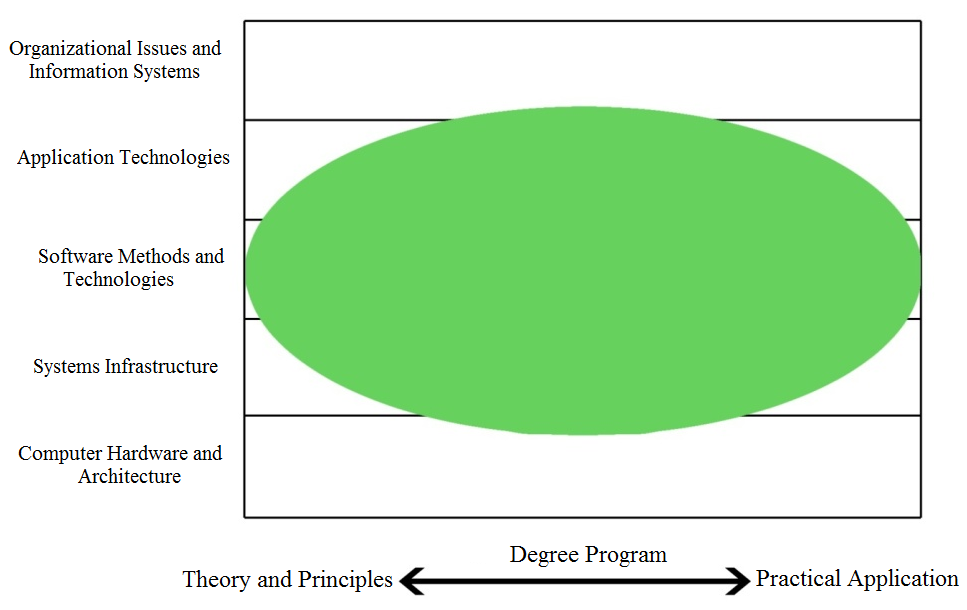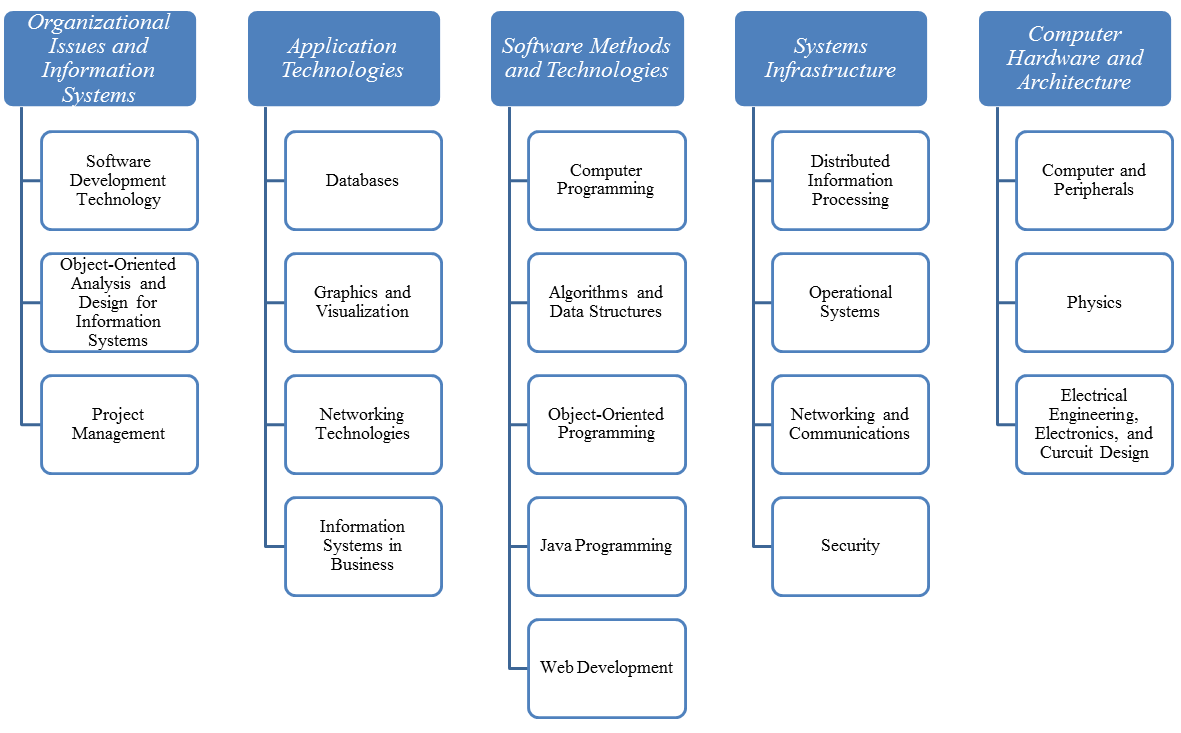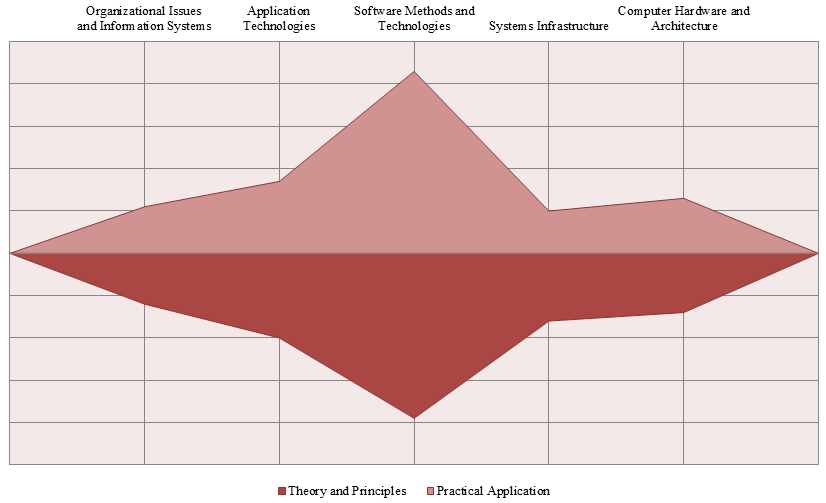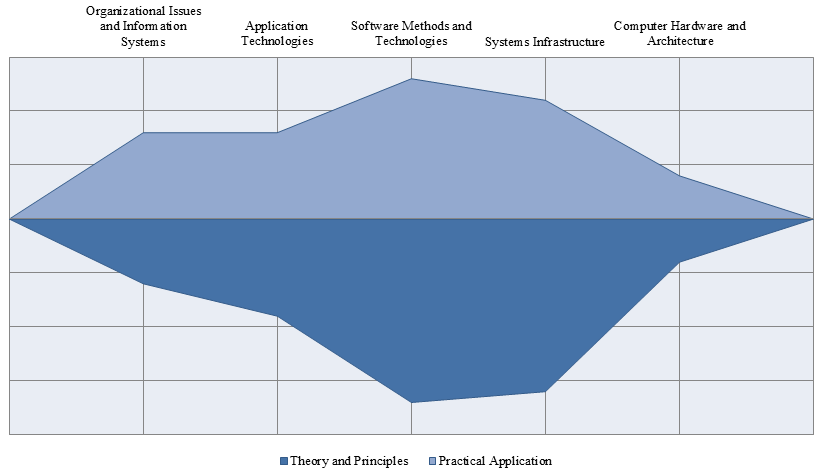Abstract
Modern society is characterized by a new stage of its social and economic development, namely “digital economy”, and this paper studies the current issues in the development of modern IT specialists training in the context of the global digitalization of economy. Since Russian universities apply new Federal State Educational Standard of Higher Education (FSES 3++) that has a framework nature and is based on the occupational standards, it becomes reasonable to implement foreign experience into Russian training of IT specialists with due regard to Computing Curricula 2005 (СС2005) (
Keywords: Information technologyIT educationeducational standardoccupational standardinternational standardsdegree program
Introduction
As modern society is characterized by a new stage of its social and economic development, namely “digital economy”, today every aspect of human activity becomes information-based and digital. Globally, targeted transition to digital economy occurred in Cancún (Mexico), June 2016 when Ministerial Declaration on the Digital Economy was adopted (Ministerial…, 2016). This document outlined the main goals of digital economy development as well as stressed the necessity to establish international technical standards able to provide compatibility and security of technologies and strongly supporting free and open access to the Internet.
In 2016, Russia also adopted its digital economy development program when Russian President Vladimir Putin in his annual message to the Federal Assembly suggested “to launch a large-scale comprehensive program to develop economy of a new technological generation, namely the digital economy” (Presidential Address to the Federal Assembly, 2016). In this new phase, Russian education system should also work towards the goals of digitalization of all aspects of human activities to train human resources for various spheres of digital economy.
Digitalization of the society increases the demand for IT graduates in economic and social sectors. Every year sees growth in number of IT specialists procured by the government, and “the number of state-funded places in Russian universities for IT students will increase fivefold by 2024 and amount to 120,000 students a year.” (News of digital …, 2019). Thus, universities attach much significance to the degree programs in Computer Science and Computer Engineering, Software Engineering, Cyber Security, and other programs related to automated systems, mathematics, computing disciplines, electronics, and radio-technical systems; IT jobs are ranked among the highest paying ones, and the development and use of information technology is consedered to be one of the most stable career paths in Russia.
The development of high-quality IT programs for various economic sectors is a top-priority not only for Russia (Truică & Barnoschi, 2015). Of special importance is software design and maintenance (Stepanova, 2019). Researchers say that having professional competencies only is not enough for an IT graduate. For instance, employers believe that young professionals should also develop communicative skills (Titthasiri, 2017). More than that, internationalization of higher education has become a global trend and IT education is no exception. Many countries have certain degree programs where not only national language but also English is used as a medium of instruction whereas insufficient English proficiency has a negative impact on the quality of education (Bradford & Brown, 2018).
Problem Statement
The problem of development of high-quality IT degree programs in higher education is connected both to the rapidly changing and dynamic nature of information technology field and to the wide and vague range of the needs of employers. The evolution of computer science as a field of knowledge and discipline in the postmodern condition (Lyotard, 1979) is described by Karakozov (2005) in his dissertation. The development of degree programs that meet the requirements of employers are studied by Karakozov, Petrov, and Khudzhina (2017) and other researchers.
Today, Russian universities are applying new Federal State Educational Standard of Higher Education (FSES 3++) and all degree programs that have already had their standards approved have to meet them from 2019-2020 academic year. For this reason, universities face an immediate task to update their degree programs in accordance with the new requirements, with the selection of and due regard to occupational standards that correspond to the field of study being at the forefront. These updated FSES 3++ standards have a framework nature. The content of a program is now formulated in a sample main degree program. Simirlarly, there is a change in competencies name, structure, and description. Every degree program must now have its competency indicators part where specific student actions assessed in the educational process are identified.
Yet, there exist several challenges in the development of updated degree programs associated with the absence or imperfection of approved occupational standards and the difficulty to predict the sphere of the professional activity of a graduate and thus to choose certain occupational standard, especially in addressing interdisciplinary tasks. One of the possible ways to develop a degree program was articulated by A. Shokhin who suggested to use a bottom-up approach (from certain professional competencies) as a key component in defining both educational and occupational standards (Professors Forum …, 2019) that is at the heart of the establishment of Russian Centers of Professional Competencies.
Undergraduate professional training in IT is based on FSES standard, occupational standards, the needs of employers, and international requirements for IT degrees, with the latter stemming from the Russian membership in the Bologna Process that makes it necessary to establish quality criteria for degree programs comparable to those established in foreign universities. Given the above, it is reasonable to study and implement foreign experience into Russian training of IT specialists. International requirements for IT degree programs are illustrated in a number of documents while Computing Curricula СС2005, (2005) that summarizes the elements that are common to all computing degree programs (CC2005) enables the researchers to develop the curricula on the basis of a general methodology. It is worth mentioning that the existing documents provide curriculum guidelines and are designed to summarize and unify the requirements for membership in the profession.
Computer Curricula international project first came into being in 1968. Modern international standards for bachelor’s and master’s degree programs in IT and their use in developing curricula are analyzed by several researchers (Sukhomlin, 2012; Sukhomlin & Zubareva, 2015) who suggest to use standard curricula versions to develop computing curriculum guidelines. Computing may be defined as any goal-oriented technical activity requiring, benefiting from, or creating computers (CC2005) and thus includes designing and building hardware and software systems, information management, computer intellectualization, etc. (Sukhomlin, 2012). Computing is also defined as an integral discipline covering a wide range of specific applied disciplines: computer science, artificial intelligence, computer networks, computational mathematics, database technologies, etc. (Sukhomlin, 2012).
Ultimately, it is necessary to find a mechanism that is able to standardize IT curricula on the basis of the curriculum approach irrespective of the country.
Research Questions
Computing Curricula (2005) singles out five major computing degree programs (СС2005):
1) computer engineering;
2) computer science;
3) information systems;
4) information technology;
5) software engineering.
Its main levels include:
1) organizational issues and information systems (information systems design and development);
2) application technologies;
3) software methods and technologies;
4) systems infrastructure;
5) computer hardware and architecture.
The portion of levels in a certain degree program determines its nature and quality while levels themselves are connected to the area of knowledge, corresponding disciplines and the curriculum of a degree program. Since every program has its own portion of the levels, the prevalance of this or that level found in the curriculum makes it possible to draw a conclusion on the focus of an IT degree program.
This research addresses the following questions:
1) which of the five major computing degree programs singled out by СС2005 does a degree program correspond to (a case study of a Russian and a European university);
2) to what extent does the degree program in IT defined by these universities meet the requirements of СС2005;
3) is it possible to provide a mechanism that is able to standardize IT curricula on the basis of the curriculum approach.
It also suggests to formulate a mechanism for making a university degree program in IT meet the international standards in order to find some strengths and weaknesses of the curricula and to develop some guidelines for their improvement.
Purpose of the Study
The overall goal of this study is to develop a mechanism that is able to standardize bachelor degree programs in IT on the basis of the curriculum approach and a comparative study of training of IT specialists in Russian and European regional universities, with a degree program in a Russian university under study corresponding to the requirements of FSES standard for this degree, occupational standards, and needs of local employers.
Research Methods
The study uses qualitative (the analysis of educational, occupational, and international standards, degree program curricula as well as the views of experts from academia and professional community) and quantitave (statistical analysis) methods.
The preliminary analysis of the compared degree programs in IT reveals that the study should use Software Engineering model (see Figure

To show how each level is represented in the context of theory and practical application aspect, a table is generated on the basis of the graphical view of a Software Engineering model (see Table
The research studies degree programs in IT in Nizhnevartovsk State University (Russia) and Liepaja University (Latvia) where both universities are similar in the number of their degree programs and students.
The study is based on the hypothesis that the universities considered here use a Software Engineering model (one out of the five of major computing models). This study supports the hypothesis and compares degree programs in IT in Russian and Latvian regional universities.
Liepaja University (LU) has a degree program in Information Technology while Nizhnevartovsk State University (NSU) has bachelor’s degree programs in Computer Science and Computer Engineering (The Software of Computers and Automated systems in particular) and Information Systems and Technology (namely, Information Systems and Technology in Business).
The study focuses on the comparison of two programs:
1) the degree program in Information Technology (LU, 4 years of study, English-taught curricula);
2) the degree program in The Software of Computers and Automated systems (NSU, 4 years of study, Russian-taught curricula).
To summarize the characteristics of degree programs in NSU and LU universities and to find out how they correspond to CC2005 levels, we ask competent experts who have been developing degree programs in IT for more than 10 years to express their view. These experts include the leading professionals in Russian and Latvian academia (Moscow State University of Education, Chechen State Pedagogical University, Nizhnevartovsk State University, and Liepaja University) and large IT companies (OOO Internet Company SIBINTEK). Table
The number in brackets indicates the number of credits brought in line with Russian standards.
Figure

Figures


As seen from the Figures, the geometric object in Figure
Findings
The analysis of IT degree programs in Liepaja University and Nizhnevartovsk State University proves our hypothesis that both universities use Software Engineering model.
Further, it is necessary to present the results of a comparative analysis of the content of the degree programs in LU and NSU in some key aspects that are crucial to developing high-quality IT programs.
First, it is important to mention that both universities provide their undergraduates with practical training while they are the 3rd and the 4th year students. Yet, credit value of the training provided differs. Liepaja University has 12 (18) credits for training of the 3-year students and 14 (21) credits for the 4-year students. Nizhnevartovsk State University gives a total of 12 credits for training its 3-year and 4-year students (6 credits each). It also provides in-school practical training for the 2-year students (3 credits). To summarize, Liepaja University provides more credits of training (26 (39)) than Nizhnevartovsk State University (15 credits). Transition of Russian universities to an updated FSES 3++ standard implies that more credits will be given to practical training. Still, the increase will not be significant.
Project activity is a key component in training a Software Engineering graduate. The curriculum of Liepaja University includes term projects from the first year of study while 4-year students write their bachelor thesis (see Table
The curriculum of Nizhnevartovsk State University includes only one project on the 3rd year of study (3 credits) and bachelor thesis (6 credits).
Thus, it can be concluded that the degree program in Liepaja University focuses more on practice and project activities that fully meets the international standard requirements for IT graduate (Sliva, 2016; CS 2013 - Computer Science Curricula, 2013).
Conclusion
The results of the study suggest some guidelines for degree programs in IT and their improvement while graphical representations identify a program’s weaknesses. Given the above, methodology described in this research (graphical representation namely) provides a mechanism that is able to highlight a degree program’s weaknesses as it is compared to one of the CC2005 models that meets the international standards in IT. Further, it is planned to extend the range of the universities and their curricula in IT to be studied to find out how they correspond to CC2005 models that were not considered here.
References
- Bradford A., & Brown, H. (2018, winter). English-medium Instruction and the Information Technology Parallel in Japanese Higher Education. International higher education. 92, pp. 24-25. Retrieved from: DOI: 10.6017/ihe.2018.92.9810
- Computing Curricula (CC2005) (2005). Association for Computing Machinery and Computer Society of IEEE. Retrieved from: https://www.acm.org/binaries/content/assets/education/curricula-recommendations/cc2005-march06final.pdf
- CS 2013 - Computer Science Curricula (2013). Curriculum Guidelines for Undergraduate Degree Programs in Computer Science. Retrieved from: https://www.acm.org/binaries/content/assets/education/cs2013_web_final.pdf
- Karakozov, S. D. (2005). Razvitie predmetnoi podgotovki uchitelei informatiki v kontekste informatizatsii obrazovaniya [The development of subject-specific training of teachers of computer science in the context of the informatization of education]. Diss. Abstract for Doctoral degree, Moscow 51 p. [In Rus.].
- Karakozov, S. D., Petrov, D. A., & Khudzhina, M. V. (2017). Proyektirovanie obrazovatelnykh programm podgotovki IT-spetsialistov na osnove trebovany rabotodatelei [Development of degree programs for IT specialists based on the needs of local employers]. Informatika i obrazovanie [Computer science and education], 9 (288), 41-45 [In Rus.].
- Lyotard, J. (1979). La Condition postmoderne: rapport sur le savoir. 97 p. Retrieved from: http://www.twirpx.com/file/155186/
- Ministerial declaration on the digital economy: innovation, growth and social prosperity («Cancún declaration») (2016). Retrieved from: http://www.oecd.org/sti/ieconomy/Digital-Economy-Ministerial-Declaration-2016.pdf
- Novosti tsifrovoi transformatsii, telekommunukatsii, veshchaniya i IT [News of digital transformation, telecommunications, broadcasting, and IT] (2019). Retrieved from: https://www.comnews.ru/content/118771/2019-03-29/oleg-podolskiy-upravlyayushchiy-direktor-centra-kompetenciy-po-kadram-cifrovoy-ekonomiki-nacproekta-cifrovaya-ekonomika-rossiyskoy [in Rus.].
- Presidential Address to the Federal Assembly (2016). Retrieved from: http://www.kremlin.ru/events/president/news/53379 [in Rus.].
- Professors Forum (2019) Professors Forum 2019 «Science. Education. Regions». Retrieved from: http://профессорскийфорум.рф/programma-foruma-7-fevralya-2019-goda/ [in Rus.].
- Sliva, M. V. (2016). Soderzhatelny aspekt mezhdunarodnogo standarta obrazovaniya v oblasti Computer Science [Contents of the international educational standrad in Computer Science]. Prikladnaya informatika [Applied computer science], 1(61), 83-92 [in Rus.].
- Stepanova, V. (2019, January). Quality Control Approach in Developing Software Projects. International Journal of Computer Science and Software Engineering (IJCSSE), 8(1), 1-5.
- Sukhomlin, V. A. (2012). Mezhdunarodnye obrazovatelnye standarty v oblasti informatsionnykh tekhnology [International educational standards in information technology]. Prikladnaya informatika [Applied computer science], 1 (37), 33-54 [in Rus.].
- Sukhomlin, V. A., & Zubareva, Ye. V. (2015). Kurrikulumnaya paradigma - metodicheskaya osnova sovremennogo obrazovaniya [Curriculum paradigm as a basic teaching method in modern education]. Sovremennye informatsionnye tekhnologii i IT-obrazovanie [Modern information technology and IT education], 1(11), 54-61 [in Rus.].
- Titthasiri, W. (2017, February). Fostering New Computer Science Graduates Capabilities through Software Engineering Class. International Journal of Computer Science and Software Engineering (IJCSSE). 6(2), 36-40.
- Truică, C., & Barnoschi, A. (2015). Innovating HR Using an Expert System for Recruiting IT Specialists – ESRIT. Journal of Software & Systems Development. https://dx.doi.org/10.5171/2015.762987
Copyright information

This work is licensed under a Creative Commons Attribution-NonCommercial-NoDerivatives 4.0 International License.
About this article
Publication Date
12 December 2019
Article Doi
eBook ISBN
978-1-80296-073-0
Publisher
Future Academy
Volume
74
Print ISBN (optional)
-
Edition Number
1st Edition
Pages
1-419
Subjects
Society, culture, education
Cite this article as:
Butko, Y. Y., Dzhambetov, E. M., Morevs, P., Gorlov, S. I., Khudzhina*, M. V., & Karakozov, S. D. (2019). Training Of It-Specialists In Russian And European Higher Education: A Comparative Study. In S. Ivanova, & I. Elkina (Eds.), Cognitive - Social, and Behavioural Sciences - icCSBs 2019, vol 74. European Proceedings of Social and Behavioural Sciences (pp. 181-190). Future Academy. https://doi.org/10.15405/epsbs.2019.12.02.22
